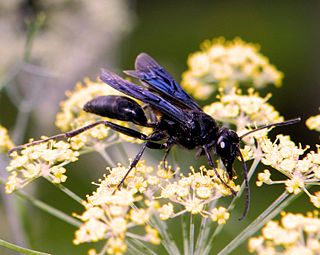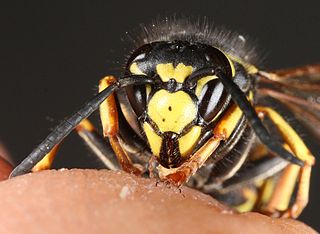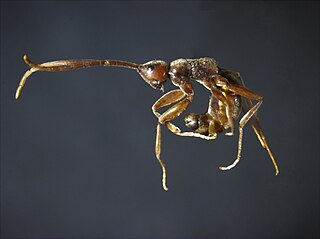External links
Coordinates: 52°47′20.1″N1°34′19.9″W / 52.788917°N 1.572194°W
The Bees, Wasps and Ants Recording Society (BWARS) is a British society dedicated to recording bees, wasps and ants.
The recording of these insects is most important to monitor the health of an ecosystem, and in the past, studies of British ants were carried out by such notable myrmecologists as Horace Donisthorpe and Sir John Lubbock.
Coordinates: 52°47′20.1″N1°34′19.9″W / 52.788917°N 1.572194°W

Hymenoptera is a large order of insects, comprising the sawflies, wasps, bees, and ants. Over 150,000 living species of Hymenoptera have been described, in addition to over 2,000 extinct ones. Many of the species are parasitic.

Myrmecology is a branch of entomology focusing on the scientific study of ants. Some early myrmecologists considered ant society as the ideal form of society and sought to find solutions to human problems by studying them. Ants continue to be a model of choice for the study of questions on the evolution of social systems because of their complex and varied forms of eusociality. Their diversity and prominence in ecosystems also has made them important components in the study of biodiversity and conservation. Recently, ant colonies are also studied and modeled for their relevance in machine learning, complex interactive networks, stochasticity of encounter and interaction networks, parallel computing, and other computing fields.

Paper wasps are vespid wasps that gather fibers from dead wood and plant stems, which they mix with saliva, and use to construct nests made of gray or brown papery material. Some types of paper wasps are also sometimes called umbrella wasps, due to the distinctive design of their nests.

The Apocrita are a suborder of insects in the order Hymenoptera. It includes wasps, bees, and ants, and consists of many families. It contains the most advanced hymenopterans and is distinguished from Symphyta by the narrow "waist" (petiole) formed between the first two segments of the actual abdomen; the first abdominal segment is fused to the thorax, and is called the propodeum. Therefore, it is general practice, when discussing the body of an apocritan in a technical sense, to refer to the mesosoma and metasoma rather than the "thorax" and "abdomen", respectively. The evolution of a constricted waist was an important adaption for the parasitoid lifestyle of the ancestral apocritan, allowing more maneuverability of the female's ovipositor. The ovipositor either extends freely or is retracted, and may be developed into a stinger for both defense and paralyzing prey. Larvae are legless and blind, and either feed inside a host or in a nest cell provisioned by their mothers.

The superfamily Ichneumonoidea contains one extinct and three extant families, including the two largest families within Hymenoptera: Ichneumonidae and Braconidae. The group is thought to contain as many as 100,000 species, many of which have not yet been described. Like other parasitoid wasps, they were long placed in the "Parasitica", variously considered as an infraorder or an unranked clade, now known to be paraphyletic.

The Schmidt sting pain index is a pain scale rating the relative pain caused by different hymenopteran stings. It is mainly the work of Justin O. Schmidt, an entomologist at the Carl Hayden Bee Research Center in Arizona, United States. Schmidt has published a number of papers on the subject, and claims to have been stung by the majority of stinging Hymenoptera.
The following are lists of insects of Great Britain. There are more than 20,000 insects of Great Britain, this page provides lists by order.

Ophrys insectifera, the fly orchid, is a species of orchid and the type species of the genus Ophrys. It is remarkable as an example of sexually-deceptive pollination and floral mimicry as well as of a highly-selective and highly evolved plant-pollinator relationship.

Formicoxenus nitidulus, or the shining guest ant, is a species of ant in the subfamily Myrmicinae. It is found in Austria, Denmark, Finland, France, Germany, Great Britain, Italy, Norway, Poland, Russia, Spain, Sweden, and Switzerland. The International Union for Conservation of Nature has assessed it as being a vulnerable species.

A wasp is any insect of the narrow-waisted suborder Apocrita of the order Hymenoptera which is neither a bee nor an ant; this excludes the broad-waisted sawflies (Symphyta), which look somewhat like wasps but are in a separate suborder. The wasps do not constitute a clade, a complete natural group with a single ancestor, as their common ancestor is shared by bees and ants. Many wasps, those in the clade Aculeata, can sting their insect prey.

Halictus scabiosae, the great banded furrow-bee, is a species of bee in the family Halictidae, the sweat bees.

Vespula austriaca is an obligate parasitic wasp, parasitizing the nests of other species in the genus Vespula in the Old World. Its common host species include V. rufa in Europe, Japan, and East Siberia.V. austriaca wasps pollinate orchids.

Megachile maritima, common name coast leaf-cutter, is a species of leaf-cutter bees in the family Megachilidae. It was described by William Kirby in 1802.

Megachile willughbiella, Willughby's leaf-cutter bee is a species of bee in the family Megachilidae. It was described by the English entomologist William Kirby in 1802; he named it in honour of the ornithologist Francis Willughby.

Nysson spinosus, the large-spurred digger wasp, is a species of cleptoparasitic wasp of the family Crabronidae which is found in the Palearctic.

Trichrysis cyanea is a species of cuckoo wasps, insects in the family Chrysididae.
Pemphredon rugifer is a species of solitary wasp in the family Crabronidae. It is found in Europe, northern Asia, and Africa.

Embolemus ruddii is a small aculeate wasp in the family Embolemidae.